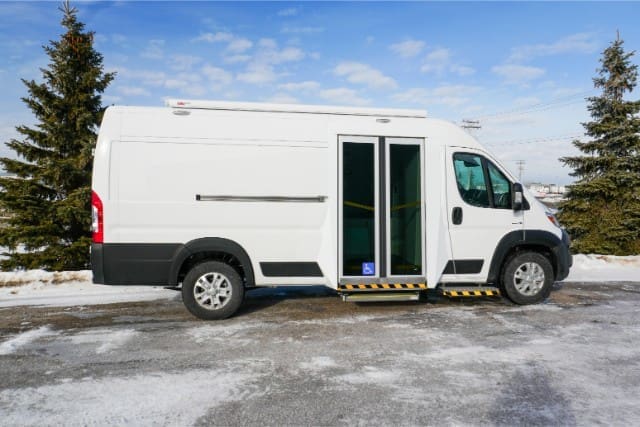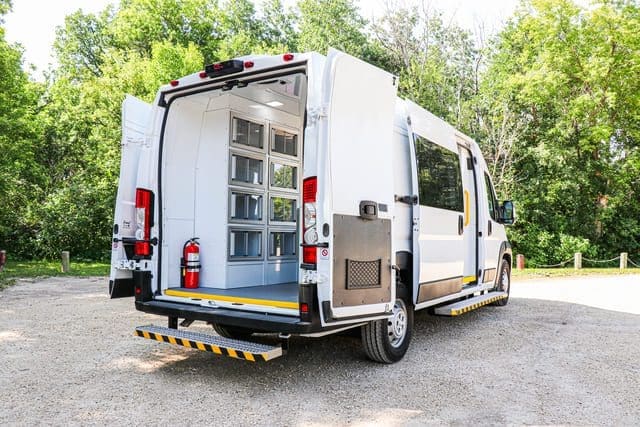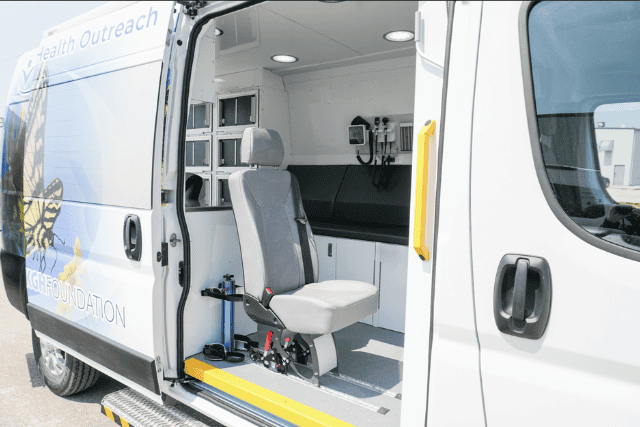Has your organization finally decided to get a mobile medical van manufactured, or are you still trying to figure out what type of vehicle to get? There are many different types and formats of these vehicles to choose from.
Choosing the wrong size means you might not have enough space for medical equipment, staff, and patients, depending on how large your program intends to be. It can also lead to a cramped workspace that congests patient healthcare services.
At AVAN Mobility, our team works tirelessly to create mobile medical van designs that fit your team’s needs. Our van solutions also make providing healthcare practical and convenient for your patients. Your satisfaction is always our top priority as we push the boundaries of mobility design. With a decade of industry experience, we’ve learned how to maximize the full potential of the size of these vans.
Keep reading to get a better idea about the size of mobile medical vans. You’ll also find a video where a past client of ours highlights that their Mobile Clinic Van is a lot more spacious than they thought.
How are mobile medical vans used?
Mobile medical vans are like traveling doctor’s offices that bring important healthcare services right to communities people live near. They help make sure everyone can get the care they need, no matter where they are.
What mobile medical vans do:
- Basic check-ups: Routine health check-ups and vaccinations.
- Health screenings: Tests like blood pressure checks and diabetes screenings.
- Crisis care: Quick help during disasters or in areas without hospitals.
- Therapy services: Mental health support, and online doctor visits.
- Community support: Health education and programs to help manage ongoing health issues.
Why does the size of mobile medical vans matter?

The size of mobile medical vans is important for several reasons.
Patient comfort and accessibility: Think about it like this – if your mobile medical vehicle is too cramped, it’s hard for patients to move around, especially if they have mobility issues. On the flip side, if the vehicle is too large, it’ll frustrate them when they have to walk longer distances around the vehicle.
The nice thing about a smaller van is it’s cozier and easier to get around. This makes patients feel more comfortable during their appointments.
Medical equipment and supplies: Your mobile medical van needs to have enough room for what your program aims to achieve. If you’re running a full medical clinic, you’ll need features like:
- An exam bed
- Sink
- Fridge
- Desk space
- Medical equipment
Workflow efficiency: A smaller van means less space to move around, but that’s sometimes a good thing. It can actually help medical staff work more efficiently because they don’t have to walk as far to get certain equipment.
Privacy and confidentiality: Everyone wants their privacy, right? Well, with a smaller van, you’re typically working with one patient at a time. It makes it easier for private consultations or exams. Plus, you can set up curtains or partitions for extra privacy when needed.
Adaptability to diverse needs: Mobile medical vans are like a blank canvas – you can customize them to fit different healthcare needs. If you’re doing basic check-ups or more specialized treatments, a smaller van can be just as versatile as a bigger vehicle.
So, while bigger vehicles might seem like the obvious choice, smaller vans have their own perks, too. They’re more personal, easier to navigate, and perfect for giving patients the one-on-one attention they deserve.
What are the size dimensions of a mobile medical van?
Let’s take a closer look at some of the dimensions of our mobile medical vans, starting with the RAM ProMaster. These numbers might give you a little more insight into how much room you think you’ll need for your mobile medical program.
RAM ProMaster 159″ wheelbase medical van
The RAM ProMaster has a wheelbase of 159 inches. The wheelbase on a mobile medical van refers to the distance between the centers of the front and rear wheels. You get 132 inches of usable interior space behind the partition in the vehicle. With this room, you can fit all your medical gear and still have plenty of space to spare for patient care.
Now, let’s talk width. With around 70 inches to work with, this van gives your healthcare team a decent amount of elbow room. Your medical staff can move around comfortably, and this ensures everyone gets the attention they need without feeling cramped.
Extended version of the RAM ProMaster
Need even more space? You can opt for the extended version of the RAM ProMaster. It adds another 14 inches to the length so that you have even more room to work with. You won’t have to worry about running out of space for your equipment or feeling crowded during medical checkups on your patients.
How does this compare to the Ford Transit?
Let’s do a quick comparison with the Ford Transit, another popular choice in the mobile medical van world.
The Ford Transit is a solid option, but it’s a tad shorter than the RAM ProMaster, measuring in at 125 inches. It might still be spacious enough for medical tasks, but you might have to get a bit creative with your layout to make everything fit just right.
When it comes to width, the Ford Transit offers around 64 inches of space. It’s a bit narrower than the ProMaster but still wide enough for smooth operations and patient care.
As you can see, the RAM ProMaster leads the pack with its spacious interior dimensions. You’ll have plenty of room to work with if you go for the standard or extended version.
How much headroom is there?
Ever wondered how much headroom you’d have inside a mobile medical van? Let’s find out:
RAM ProMaster height: The RAM ProMaster gives you a generous headroom of 72 inches. That’s enough space to stand up straight without bumping your head, depending on how tall you are. Most people will feel comfortable moving around inside this van.
Ford Transit midroof height: The Ford Transit has a midroof height of 69 inches. While slightly lower than the ProMaster, it still offers ample headroom.
Take a look at the table below for a quicker glance into the dimensions of each.
| Feature | RAM ProMaster 159″ | Ford Transit |
| Wheelbase | 159 inches | 125 inches |
| Usable Interior Space | 132 inches | 125 inches |
| Width | 70 inches | 64 inches |
| Headroom | 72 inches | 69 inches |
| Extended Version Length | +14 inches | N/A |
Are there regulations for the size dimensions of mobile medical vans?
When it comes to the size of mobile medical vans, one important rule to follow is ADA compliance. This means making sure the vans are accessible to people with disabilities. The ADA website has some fairly detailed information on that.
Your next steps with AVAN Mobility
You came to this article looking for more information on the size of mobile medical vans. After reading this far, you now know about the specific dimensions of these vans and how they can impact your mobile medical program.
Now that you know all about the size of mobile medical vans, you might be wondering what your next steps are. Our RAM ProMaster and Ford Transit vans are designed to break healthcare barriers so everyone can get the care they need.
Watch the brief video below for a closer look at the interior space of our mobile medical vans.
We also encourage you to check out another video from one of our past clients who purchased a Mobile Clinic Van from us.
Lastly, you should read through our articles on mobile clinic design, mobile medical unit space constraints, and whether a mobile medical bus is too big for your needs. These articles will give your organization a better idea if mobile medical vans are the right fit.
If you’re a healthcare professional or an organization looking to make a difference and save lives, our vans are ready to roll. Reach out to us today to learn more and see how our vans can transform healthcare delivery in your community. Click the button below to get started.





